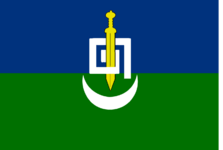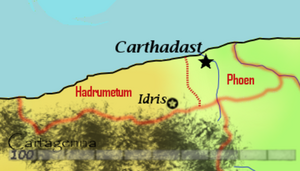Cartagenna
Overview
Founded at the peak of the Thracian Empire, Cartagenna has remained an outpost of the Thracian ideal for centuries, but with its own west Meridian flair. Cartagenna is at the farthest western extent of the habitable lands of the continent, with its sea shore all but adjacent to the massive Maelstrom that blocks sea travel beyond it. It is bordered by the ancient kingdom of Songhai and Damascus to the east, and the Madras Mountains to the south and west, protecting it from the all-consuming Demon Wastes to the south. The land is mostly semi-arid, but features two opulent river valleys in the East. The capital city of Carthadast is located at the mouth of the Oum Morbeia, the smaller of the two rivers.
The population of Cartagenna is mostly a blend of Human and Outlander peoples, fairly well integrated, but has a strong minority of goblinoid peoples from the mountains, particularly ogres. Organized into a nation that partially emulates the structure imposed by Thracia at the height of its power, citizenship is an important consideration and class structures are flattened by that emphasis.
Through its whole history Cartagenna has struggled with the dangerous and aggressive weather and currents that originate in the Maelstrom to the north. From 2010 onward, the Maelstrom has been in one of its more active periods, meaning that agriculture in Cartagenna has struggled with extreme southerly winds dragging desertification down and through the mountains. Each successive year's yield has been slightly more alarming, and Cartagenna is struggling at the limits of their habitual preparedness.
Culture
There are several strong cultural branches that blend together in Cartagenna. The Outlander people of the deserts have a semi-nomadic lifestyle and a proud independent ideology. The Haman Sook Ogres of the mountains are another strong cultural group, living in alpine mound fortresses that act as the front line against demonic incursion through the mountains. In the river valleys, several cultural/tribal groups maintain a strong representation in the blend of Cartagennan lowlanders, where the emphasis is aggressive sustainable agricultural production.
Religions
what faiths are present, what are the views on faith
Social Structure
The people of Cartagenna are structured into three primary classes. There are citizens, free peoples, and slaves. Citizenship is held as a lofty ideal that creates fundamental equality, and more so even than in Thracia itself the class of citizenship brings a profound sense of equity between persons of different means or lifestyles. While there is an aristocratic upper class who participates in governance as members of the Senate, the Senators strive to maintain a veneer of being no better than other citizens, and it is very important to avoid distinctive ostentation that would differentiate the senators from other people.
Customs and Holidays
What days matter to the people
Arts and Exceptionalism
Politics
Government
Cartagenna is ruled by a monarch, currently Queen Salemi-Sahar, but the Monarch and their heir is determined by the self-appointing oligarchical Senate which handles most matters of governance. They oversee a modest bureaucracy full of appointed offices held by citizens of many stripes.
The Monarch is chosen as heir by the Senate and is subject to change in station contingent upon their action, but is drawn from a royal family of ancient lineage. When Thracians originally colonized, they sent their own governors. Some of the early governors married into local Outlander tribal royalties to create a firm aristocracy, but that aristocracy dwindled as the retreat of Thracia left its ideals to be interpreted by a more dominant local population. The royal family has very few and limited privileges, but is the pool from which the monarch is always selected. As such, marriage into the primary branch of the royal family is also subject to senate approval.
The Senate appoints its own membership, drawing from the moneyed politicos of the country on a basis that mixes governing compatibility with popular enthusiasm. The body of the senate determines most ordinary functions of government.
The monarch serves as the Priceps of the Senate, participating in its function while holding absolute veto power over any of its actions or choices, and sets the tone and direction of policy.
The monarch can be removed by a super-majority vote of the Senate, being the only decision besides selection of the heir the monarch themselves cannot overrule, but this has happened only very rarely and under extreme circumstances twice in Cartagenna's history. A monarch can also resign, which happens more often amongst the aged or ineffectual.
The military of Cartagenna is structured after the Thracian Legions and is ultimately answerable to the Senate. The monarch has their own specialized guard force, the Excubitors, who exist outside the general military structure.
Organization of the Land
How the power structure is divided regional (i.e. Duchies, Baronies, Lordships, etc.)
Demographics
Economy
Foreign Relations
History
History since the Dragon Wars
Early History
National History
Major Modern Events
What events will have shaped the experience of characters having grown up there
Geography
The physical lay of the land

